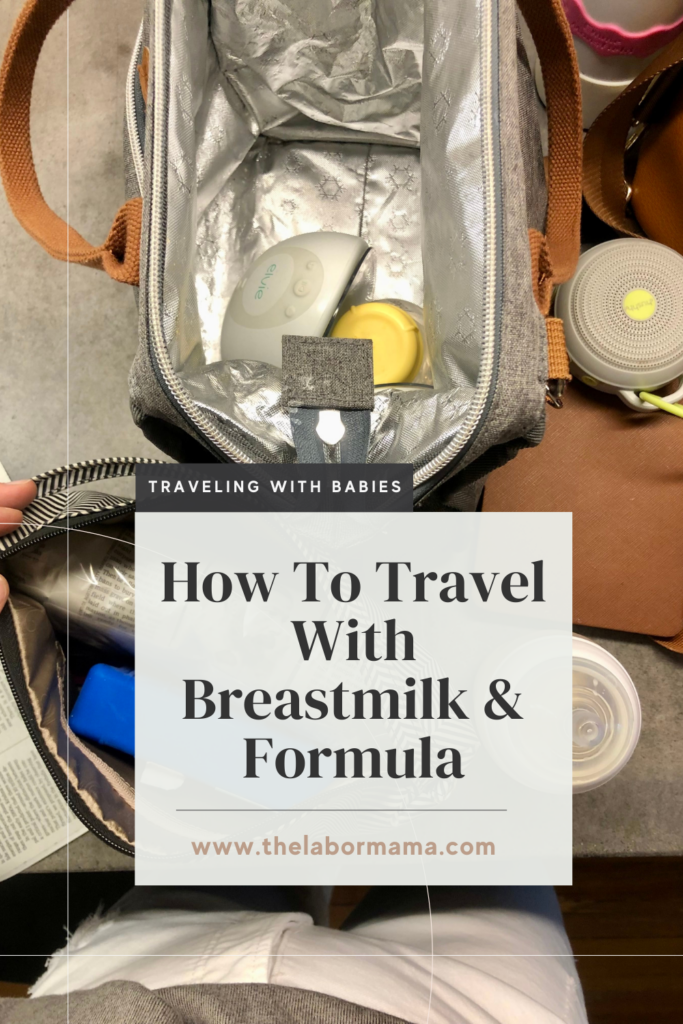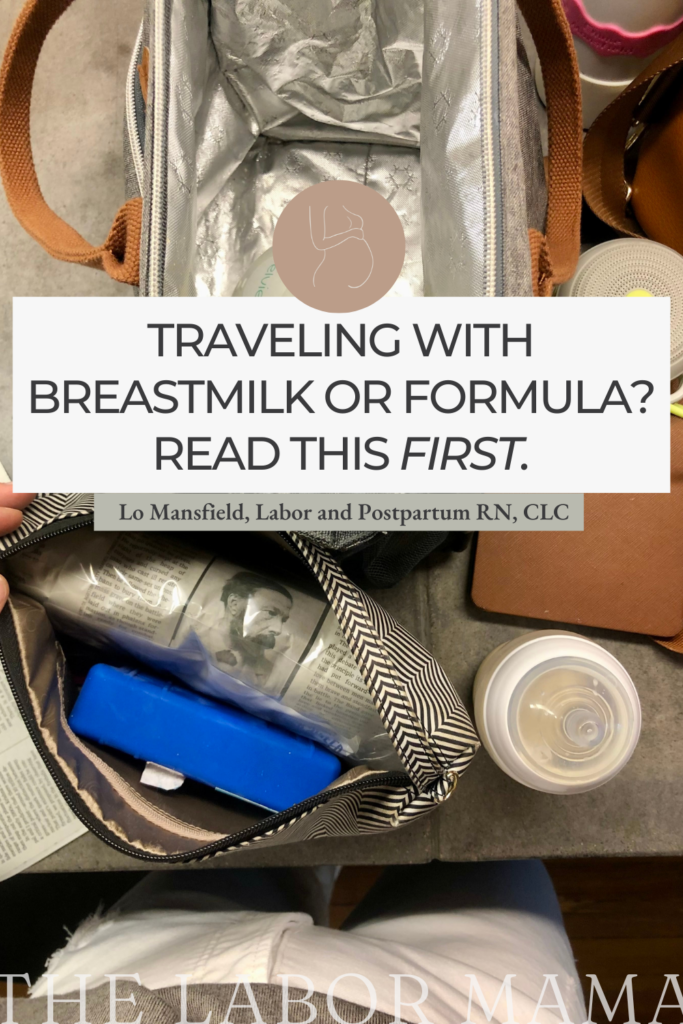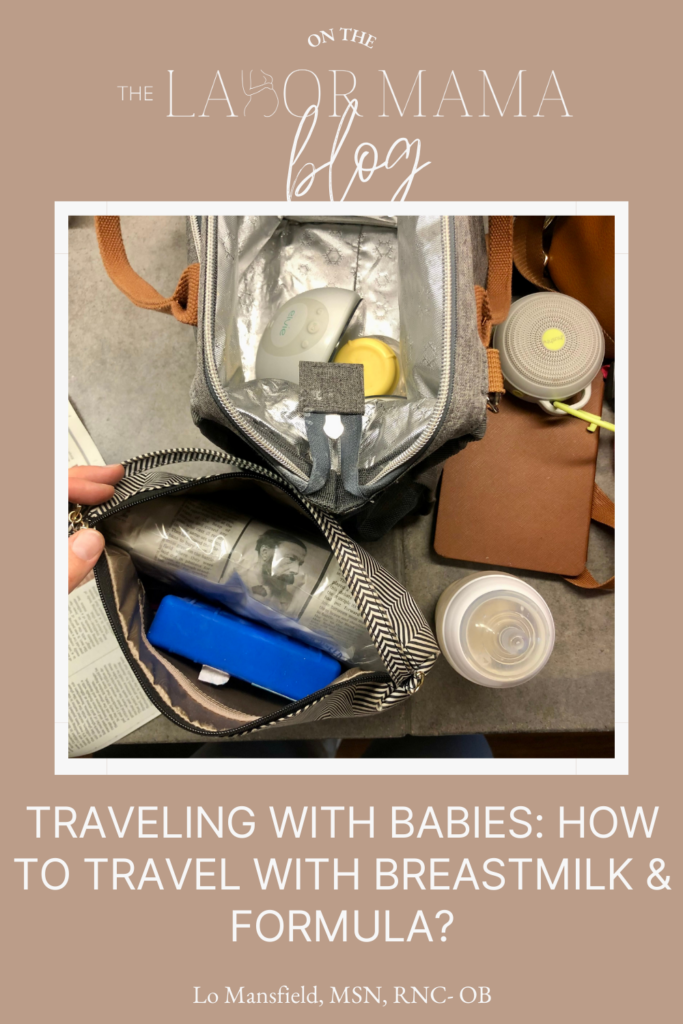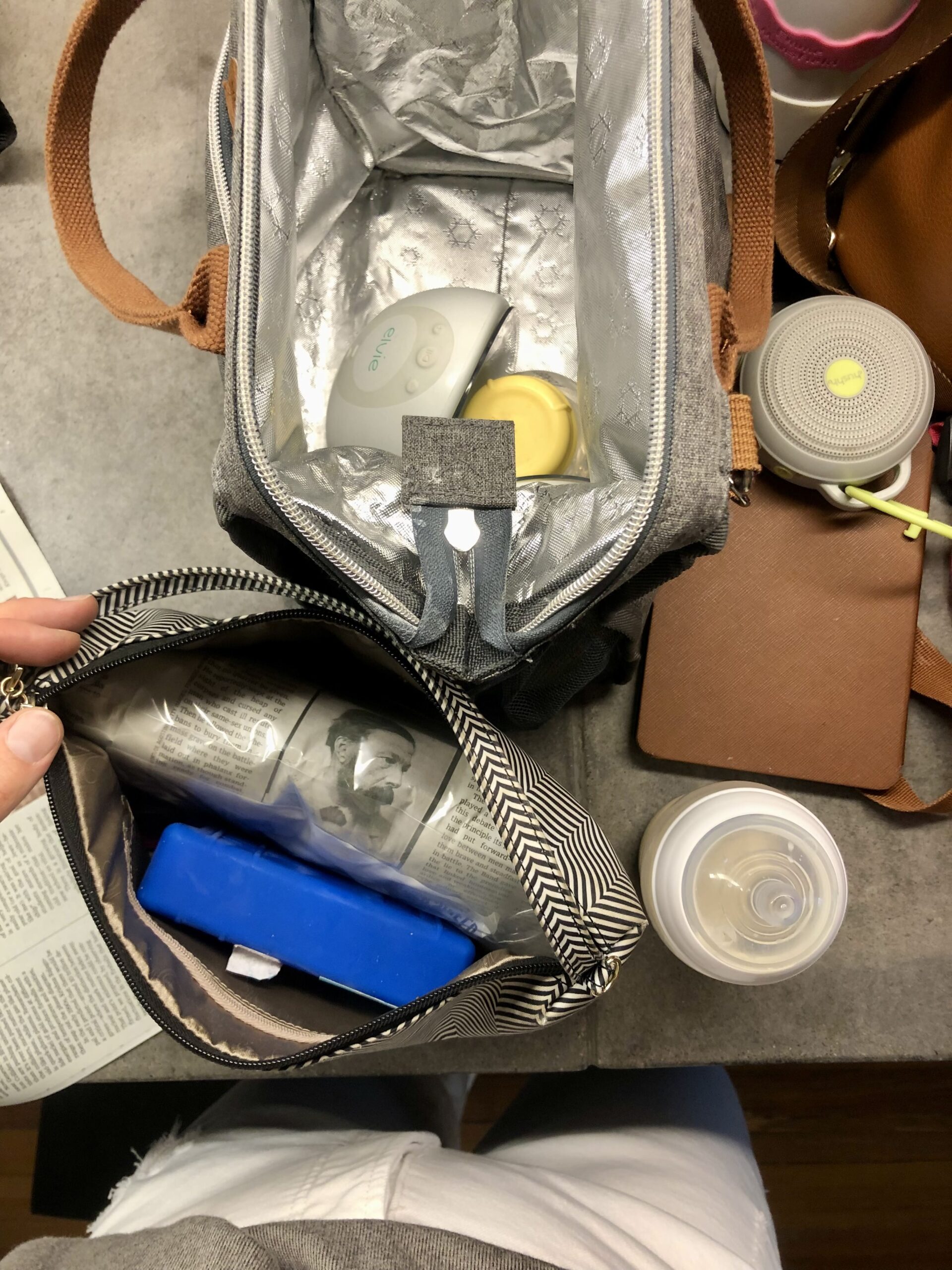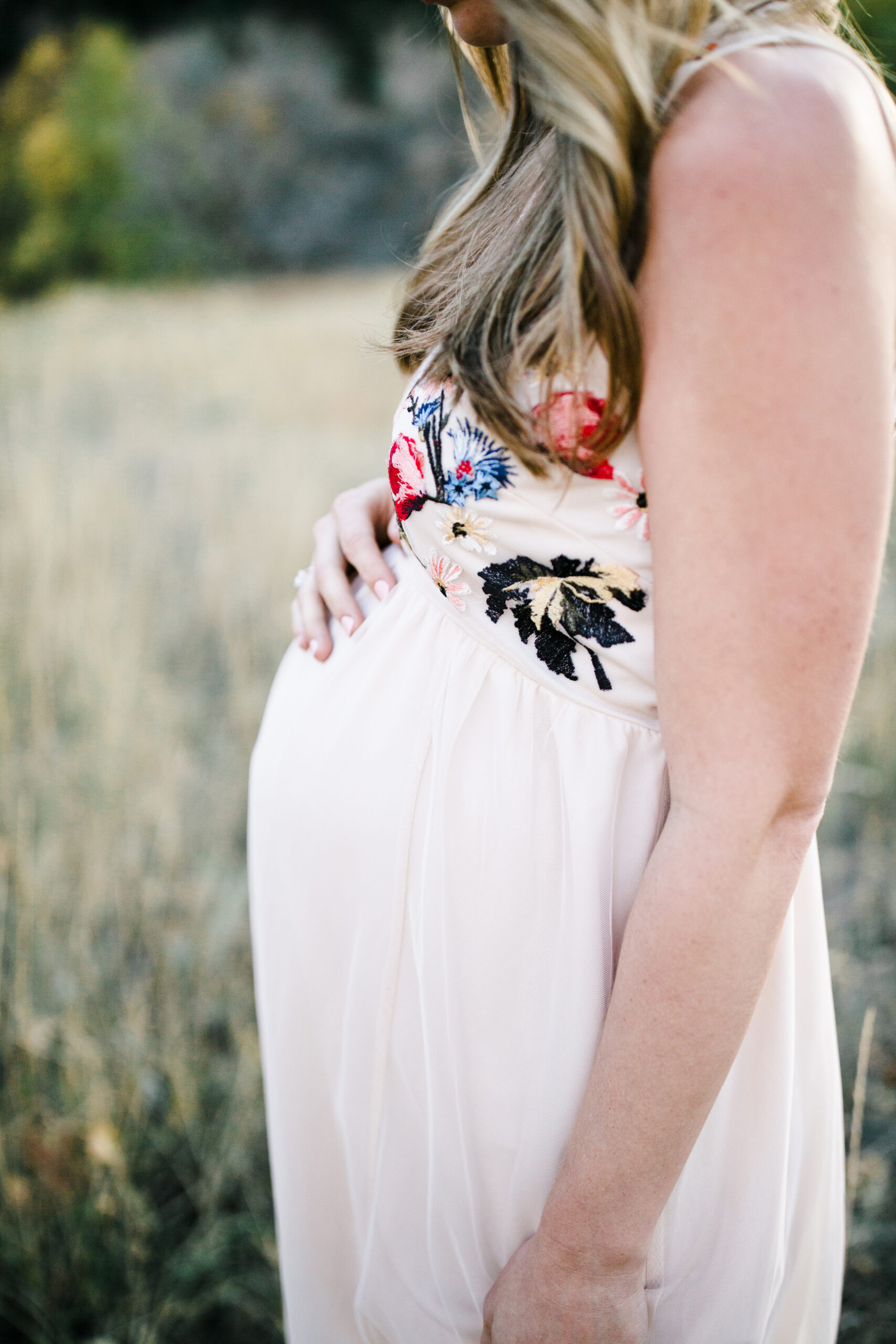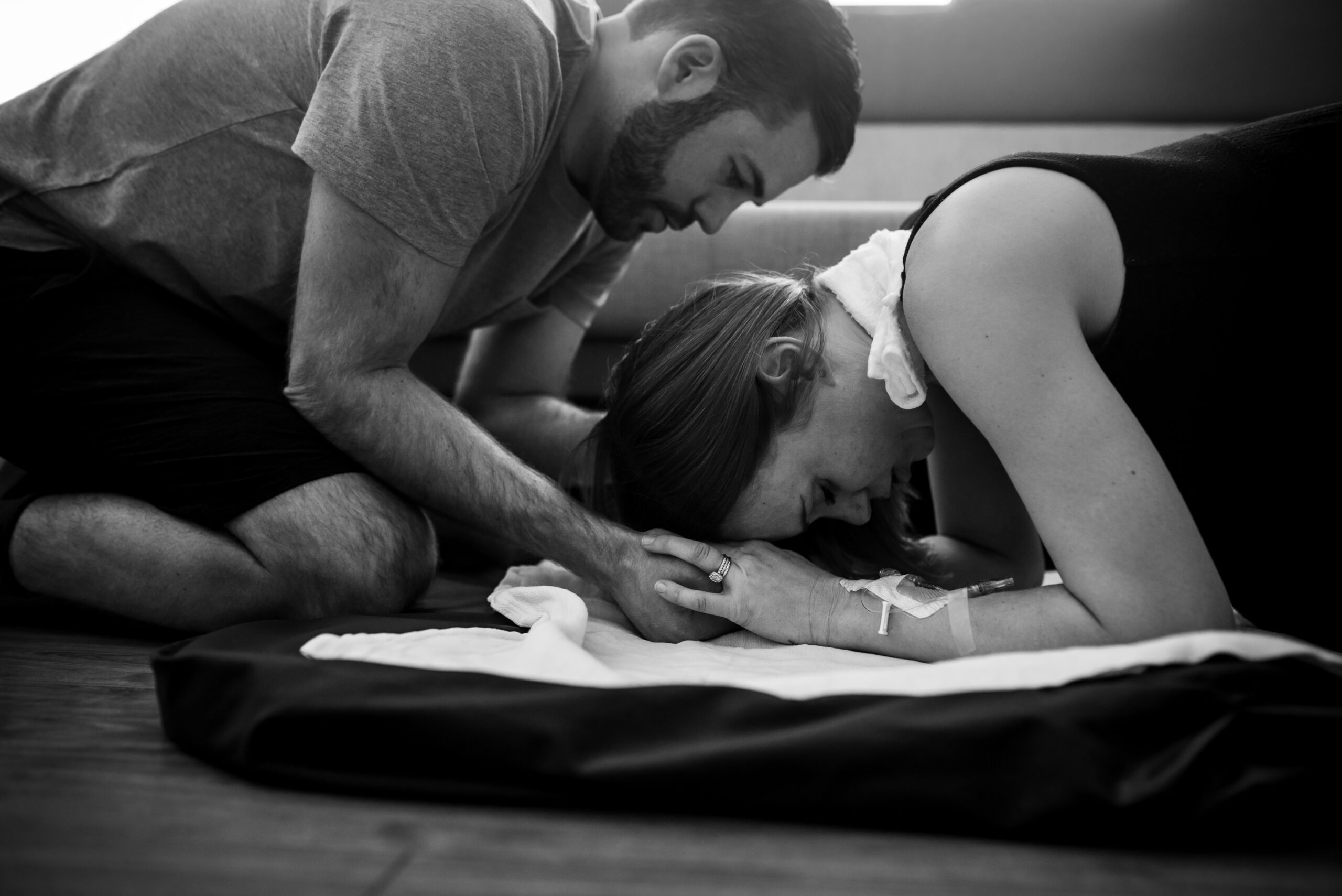It’s finally happening. You’re doing it..traveling for the first (or 100th) time with your sweet breastfed or formula fed baby. You go, mama! I promise you that you CAN do this. However, I’m sure you have some questions (I definitely did my first time). Or maybe you’re feeling nervous about traveling with breastmilk or traveling with baby formula, wondering how to travel with a breast pump, or not sure how to prepare formula while traveling.
First, take a deep breath and know that this can be done (and often, go really well), even while it feels really stressful. Secondly, don’t panic! As a mom of four who has traveled tons with littles and even lived overseas, I’m going to share with you my best tips & tricks. We’re going to chat about:
- What are the TSA regulations for carrying breastmilk or formula on a plane?
- How should I store breastmilk or formula while traveling?
- Can I bring a breast pump through airport security?
- How can I maintain my pumping schedule while traveling?
- How can I prepare formula while on the go?
- How can I sanitize bottles and pump parts while traveling?
So grab your cup of coffee and settle in, because by the end of this blog post my hope is that you feel prepared to conquer traveling with your littlest little (and even any bigs too), all while making sure they are fed the way you want them to be the whole way.
But before we dive into how to travel with breastmilk and formula – Who is The Labor Mama and Why Am I Here?
Hey friend! I’m Lo – also known around here and social media as The Labor Mama. I’ve spent my nursing career in labor, delivery, and postpartum, have birthed 4 of my own babies, have labored thousands of mamas at the bedside, have taught thousands of students online, and have even delivered a few speedy little babies with my bare hands (oops).
Here at TLM, I offer online classes about birth, postpartum, newborn care, and breastfeeding to empower you the way everyone should be. The education + support I offer gives you experience, evidence, and empathy; you’re getting all of my years of “clinical” RN knowledge, honestly combined with my real experiences as a mama and a nurse. These are not your average hospital classes (those won’t do it, I promise), and honestly, birth, postpartum, and breastfeeding don’t follow a textbook or protocol anyway. You need to know so much more than that!
If you want to connect with me further, head to Instagram. There are hundreds of thousands of us over there learning together daily.
A note: This post may include affiliate links. This means if you make a purchase after clicking a link, I will earn a small commission (thank you)! Rest assured, this comes at no additional cost to you. You can read TLM’s full disclosure here.
Understanding TSA Regulations for Breastmilk and Formula
Let’s talk about getting through TSA with breastmilk or formula. It’s one of those things you might not think about until you’re packing for that first trip with your little one, and suddenly you’re like, “Wait, can I actually bring this on the plane?” Spoiler: You can, but there are some things you need to know.
First up, yes, you can bring breastmilk, formula, and even juice for your baby through security, and there’s no need to stress about the 3.4-ounce rule that applies to most liquids. Breastmilk, formula, and liquids specifically for your baby are considered medically necessary liquids, which means you can bring more than 3.4 ounces.
PRO TIP: Jump onto the TSA website and print the rules off! Tuck these rules into your bag just in case you run into any trouble with someone who is confused.
At the airport, one of the best things you can do is let the TSA officers know you’ve got any of this with you when you reach the security checkpoint. They’re gonna want to screen it, and that might mean X-raying the bottles or pouches (don’t worry, it’s safe for your milk or formula to be screened). If you want to skip the x-ray, you can ask and they can accommodate that too.
Heads up — sometimes they might ask you to open the container/cooler for additional screening, especially if you deny the x-ray machine.There are a few different alternative screening methods, like a quick pat-down and testing the outside of the container. Honestly, I’ve had them do all of it sometimes too.
The key here is being prepared and knowing what to expect. To be honest? This process feels ridiculous to me every time. I’ve never had them move quickly. And I always feel like I’m a pain in the ass for bringing milk through. But you can. It’s fine! Do what you need to — and definitely know the rules (the printout!) if they try to tell you something different.
Overall, you have to remember that this whole process will take extra time. Do not cut yourself short on time if you are trying to get through with breastmilk or formula. Yes, you can get through, but it’s rarely a fast process, even when you follow the rules and are ready for TSA.
Storing and Keeping Breastmilk or Formula Cold While Traveling
So, you’ve made it through security, and now it’s all about keeping that breastmilk or formula fresh for your baby. Whether you’re flying, driving, or on the move for a long day, here’s how to store and keep your baby’s milk cold throughout your trip.
First off, if you’re dealing with fresh breastmilk, you want to store it in a way that maintains its temperature. Remember:
- Freshly pumped milk is good in the refrigerator for up to 4 days.
- Defrosted milk (if you’re traveling with frozen) is good/needs to be used within 24 hours of it defrosting.
If your milk is in bags, an insulated cooler with ice packs is your best friend here. These coolers can keep milk cold for several hours, making them perfect for flights or road trips. If you’re traveling for more than just a few hours, you might want to look into portable coolers specifically designed for breastmilk. These coolers are compact but do a great job of keeping milk at the right temperature for up to 24 hours. These are some of my favorite coolers; I used one of these for over 6 years before replacing it! The ceres chill is another great choice, especially if the milk isn’t in a bag. You can travel with milk directly in the inner or outer chamber and then pour straight into a bottle when it’s time!
I do have a discount code for the Ceres Chill. Use: THELABORMAMA at checkout and save 15%!
This is how I packed my bag with frozen pumped milk when I have traveled previously:
I had one defrosted bottle of 3 ounces in here. I wrapped 4 packs of frozen milk in newspaper, put it in a ziploc, and then put it in the zipper pouch with an ice pack. Then my pouch went in the cooler with extra bottles and my pump and just carried it all on. I didn’t get stopped at all because everything was under the ounce rule.
When flying, you can bring gel or liquid ice packs through TSA as long as they’re being used to cool breastmilk or formula. Just pack them with your milk in an insulated cooler, and you’re good to go. As a heads up – make sure they’re totally frozen when you go through TSA! I’ve had TSA take some of mine if there was liquid inside of them that wasn’t frozen. If you’re driving with your breastmilk (on either end of your trip), place the cooler in the coolest part of your car, away from direct sunlight, and try to check on it minimally (to keep the cool in) to make sure everything’s staying cold.
For longer trips or overnight stays, you might need to get a bit more creative. Most hotels have mini-fridges in the rooms—just call ahead to confirm. If not, many hotels are happy to store your milk in a staff fridge. Label your bags or bottles clearly, so there’s no mix-up.
Another tip—if you’re pumping on the go, use storage bags that are leak-proof and easy to label. These bags lay flat in the cooler, making them easy to stack and store. If you can freeze them wherever you are, even better. And for formula, pre-measure the powder into a dry container, so you can mix it with bottled water when your baby’s ready to eat. I love this little container so much and it doubles for snacks when baby is bigger!
Staying organized is key. Keep your milk or formula in a separate bag from your other carryons, so it’s easy to grab when you need it. If you want to warm a bottle on the go (my kids never took cold breast milk), I love this bottle warmer and it’s easy to pack! Warm or cool, you’ll always want to check the milk’s temperature before feeding it to your baby. Baby can definitely drink cold breastmilk, but you’ll want to make sure it isn’t frozen/no ice crystals.
Shop my traveling with breastmilk favorites here.
Traveling with a Breast Pump
Let’s dive into the breast pump situation. If you’re traveling with one, you might be wondering how to get it through security and what to expect along the way. Good news—it’s easier than you might think, and with a little planning, you’ll have no trouble keeping up with your pumping routine.
First off, yes, you can bring your breast pump on the plane, and it won’t count as one of your carry-on items. It’s considered a medical device, so you’re allowed to carry it in addition to your regular luggage. Just make sure your pump and all its parts are clean and dry before you pack them up, so you’re not dealing with any messes or extra hassle when you get to security.
When you reach the security checkpoint, let the TSA officers know that you’re carrying a breast pump. They’re used to seeing these, so it shouldn’t be a big deal, but it’s always good to give them a heads-up. They might ask to screen the pump separately, especially if it’s in its own bag (I keep mine separate), so be prepared to take it out and place it in a bin like you would with a laptop.
If your pump has batteries, they may need to inspect those as well. If you want, you can just pop them out of the device beforehand to make things easier. And if you’re carrying any milk you’ve pumped before you got to the airport, remember to follow the same TSA guidelines we talked about earlier for breastmilk— there is no 3.4-ounce limit, and they can’t ask you to discard it!
Once you’re on the plane, don’t worry about finding a place to pump. Most airlines are accommodating if you need to use the bathroom or even a galley area for privacy. Some moms also prefer to use a manual pump or a wearable electric pump that’s more discreet, so they can pump right in their seat. If that’s your style, go for it! And if you want to do it underneath a cover, I’ve been there too! Milk Snob’s 5-in-1 cover is one of my favorites, and I love that they have so many different prints and color options.
Curious about my favorite wearable/portable pumps? I share all of them in this blog post.
If you’re driving, your pump can go anywhere with you, no problem. You probably already know that. Just make sure you have a power source, whether it’s a car adapter or a portable battery pack, so you’re not stuck without a way to pump when you need to.
Traveling with a breast pump might sound like a lot, but once you’ve done it a couple of times, it becomes second nature. Keep your routine as close to normal as possible, and you’ll be good to go!
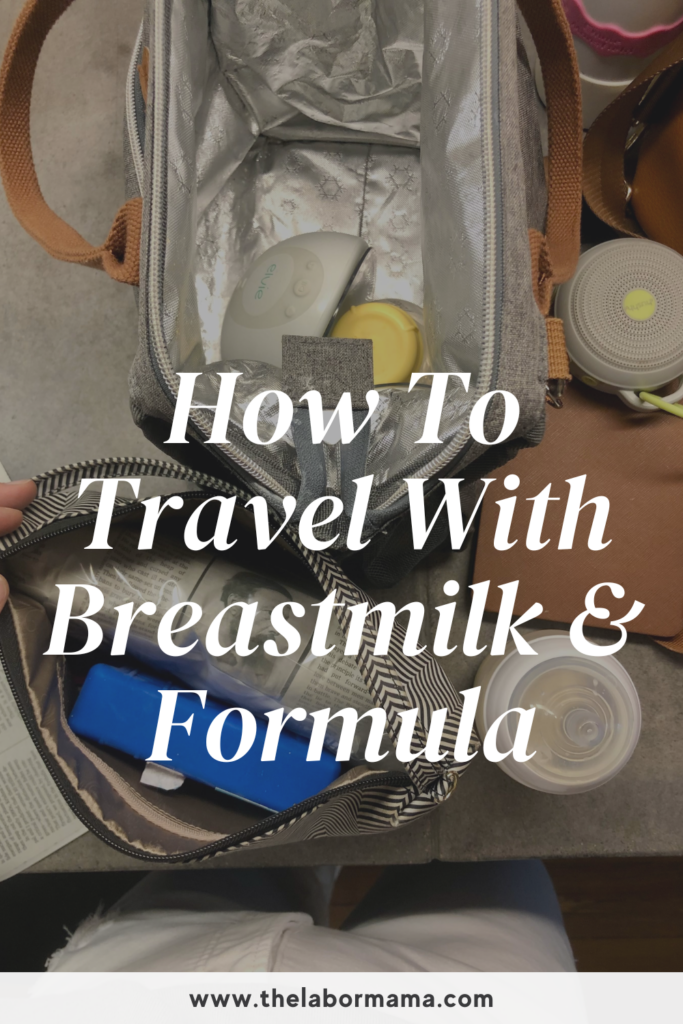
Maintaining Your Pumping Schedule While Traveling
Keeping up with your pumping schedule while traveling can feel like a challenge, but with a little planning, it’s totally doable. Whether you’re on a plane, driving cross-country, or exploring a new city, staying consistent (as much as you can) with your pumping routine is important for maintaining your milk supply and for your comfort.
First, let’s talk about planning ahead. Before you leave, take some time to think about your typical pumping times and how they’ll fit into your travel schedule. If you’re flying, it’s a good idea to pump right before you leave for the airport and then again once you’re through security. Many airports have nursing rooms or family lounges where you can pump in privacy.
PRO TIP: If you can’t find a lactation room, ask the airport staff OR check out Mamava. The webpage or the free app helps you locate these little pods that are in airports (and other places) for you to use. It’s pretty great!
On the plane, most airlines are accommodating if you need to pump during the flight. You can use the bathroom if you prefer privacy, though some moms find it easier to pump discreetly at their seat using a manual or wearable pump or simply throwing a cover or blanket over themselves. Wearable pumps in particular are great for travel because they’re hands-free and often quieter, making them a convenient option for pumping on the go.
If you’re driving, your car can definitely double as your pumping station. Just make sure you have a car adapter for your electric pump or bring along a battery-powered pump. Find a safe place to pull over, and you can pump right in the car. If you’re traveling with someone else, they can take over driving while you pump in the passenger seat. And don’t forget to bring a cooler, insulated bag with ice packs, or your Ceres Chill (code: LABORMAMA saves 15%) to store your milk until you reach your destination.
Staying hydrated and well-nourished is also key to maintaining your milk supply while traveling. It’s easy to get dehydrated when you’re on the move, especially if you’re flying, so keep a water bottle with you at all times and make sure you’re eating regularly. Snack bars, nuts, and fresh fruit are great options to have on hand.
Another tip is to bring along extra pump parts and storage bags (these ones are my absolute favorite). Travel can be unpredictable, and the last thing you want is to be stuck without a clean set of pump parts or a place to store your milk. Pack a small kit with spare parts, wipes for quick cleaning, and a few extra storage bags or bottles, just in case. I also love bringing along a travel drying rack and a sterilizer bag, so you can fully clean and/or sterilizer your things once you get to where you’re going.
If you’re staying in a hotel, call ahead to see if they have a fridge in the room or if they can provide one. Most hotels are used to accommodating breastfeeding moms and are happy to help you store your milk safely.
Lastly, don’t stress too much if your pumping schedule gets a little off-track. Travel can be hectic, and sometimes you might need to adjust your routine slightly. The important thing is to try to pump regularly and not go too long between sessions. Your body is pretty adaptable, and with a bit of flexibility, you’ll be able to maintain your supply and keep up with your pumping while on the go.
Preparing Formula On-the-Go
When you’re out and about with your little one, being able to prepare formula quickly and easily is a must. Whether you’re on a plane, in a car, or just out for the day, having a solid plan for mixing up a bottle on the go can make all the difference.
First, let’s talk about convenience. Pre-measuring your formula powder before you leave the house is a game-changer. You can use formula dispensers like these that have separate compartments for each serving, making it super easy to just dump the powder into a bottle when your baby’s ready to eat. This way, you’re not fussing with measuring scoops while juggling a hungry baby.
When it comes to water, the best option is to carry bottled water that you know is safe for mixing with formula. Many parents prefer to use room-temperature water, which means you don’t have to worry about finding a way to warm it up. If your baby prefers warm bottles, consider using a portable bottle warmer. These can heat up the water in minutes, even in the car or on a plane. Some warmers are even USB-powered, so you can plug them into your phone charger or laptop if needed.
If you’re flying, it’s worth knowing that TSA allows you to bring a reasonable amount of water for formula through security, even if it’s more than the typical 3.4-ounce limit for liquids. Just let the TSA agents know what you’re carrying and that it’s for your baby – they’ll likely screen it separately.
Another tip is to prepare bottles in advance if you know you’ll need them soon after leaving the house. Mix the formula with water, shake it up, and then store the bottle in an insulated cooler bag to keep it fresh until it’s feeding time. Just be sure to use the bottle within the recommended timeframe for mixed formula, which is usually about two hours at room temperature or up to 24 hours if kept in a cooler.
Lastly, remember to pack a few extra bottles and formula servings, just in case you run into delays or your little one is hungrier than usual. It’s always better to have a little more than you need than to find yourself without!
Sanitizing Bottles and Pump Parts While Traveling
Traveling with a baby means keeping everything as clean as possible, especially when it comes to bottles and pump parts. Whether you’re staying in a hotel, visiting family, or on the go all day, finding ways to sanitize your baby’s feeding gear is essential for their health and your peace of mind.
First, let’s talk about quick and easy solutions. Disposable bottle liners (if your bottle has the option) and pre-sterilized disposable nipples are a great option if you’re looking to minimize the need for cleaning on the go. These can be a lifesaver when you don’t have access to a sink or a way to properly wash your bottles.
If you’re using regular bottles, portable sterilizing bags are a must-have. These bags can be used in a microwave to steam sterilize your bottles and pump parts in just a few minutes. They’re compact, easy to pack, and can be reused multiple times, making them perfect for travel. Just fill the bag with a bit of water, pop it in the microwave, and you’ve got clean, sanitized gear in no time.
A note: The CDC recommends washing your pumps parts with soap and water after every use, and sanitizing relatively often depending on the age and health of your baby. However, there are time where moms are using other options until they get to a place where they can utilize soap and water or find a way to sterilize. Full CDC guidelines for cleaning pump parts are here.
No microwave? No problem. You can use cold water sterilizing tablets or solutions. These are designed to sterilize bottles and pump parts in cold water, making them ideal for situations where you don’t have access to a microwave or hot water. Simply dissolve the tablet or solution in a basin of water, submerge your bottles and pump parts, and let them soak for the recommended time. It’s an easy, fuss-free way to keep everything clean, even when you’re off the beaten path.
For shorter trips or during the day, sanitizing wipes are a great backup. These wipes are specifically designed for baby bottles and pump parts, and they’re perfect for giving everything a quick clean between uses. Just make sure the wipes you choose are safe for baby feeding items—regular disinfecting wipes aren’t suitable for this purpose.
If you’re staying in a hotel or with family, ask if you can use their dishwasher or a sterilizer. Many hotels have small kitchenettes or access to a communal kitchen where you can wash and sterilize your baby’s bottles. If you have a bit more space in your luggage, a portable bottle sterilizer can be a good investment. These devices are compact and can be plugged in anywhere, giving you a convenient way to sanitize your baby’s feeding gear wherever you are.
Remember to pack a small bottle of dish soap and a travel-sized bottle brush for washing bottles and pump parts by hand. You can use the sink in your hotel room or a bathroom on the go to give everything a thorough clean before sanitizing. It’s also a good idea to bring along a drying mat or drying rack to lay everything out on after washing.
Staying on top of sanitizing your baby’s bottles and pump parts might seem like an extra hassle when you’re traveling, but it’s another one of those things that will also become second nature with a little practice. Plus, knowing that everything is clean and safe for your baby will help you relax and enjoy your trip and bring that precious milk back home!
To wrap up this post about traveling with breastmilk and formula…
Traveling with a baby, especially when you’re managing breastmilk or formula, might seem daunting at first, but with the right preparation, it’s entirely manageable. From understanding TSA regulations to keeping milk cold and maintaining your pumping schedule, you’ve now got the tools and tips to ensure that your little one is well-fed and happy throughout your journey. Remember, it’s all about planning ahead, staying organized, and being flexible when things don’t go exactly as planned.
You’ve got this, mama! With each trip, you’ll gain more confidence, and soon enough, traveling with your baby (or pumping without them) will feel like second nature. So take a deep breath, pack those essentials, and enjoy the adventure with your little one by your side.
Looking for all of the travel essentials? I’ve linked all my favorites for you in my Amazon storefront.
If you have any questions or need more tips, feel free to leave a comment below or check out my full travel highlight on IG.
Now let’s keep this conversation going, do you have any tried and true tips for traveling and feeding your littles? I would love to know!
Safe travels!!
-xx, Lo
Loved this blog post? Here’s some others you’ll probably like:
- Power Pumping For Low Milk Supply
- The Best Lactation Cookies & Energy Bites for Milk Supply
- How to Build a Breastmilk Freezer Stash
More resources (and freebies!) for you to take a peek at:
- Comprehensive Birth Plan and Birth Priorities templates
- A complete Third Trimester Checklist
- The RN + mama of 3 Ultimate Packing List
- The Labor Mama online birthing classes for every family
- Amazon Breastfeeding Favorites
